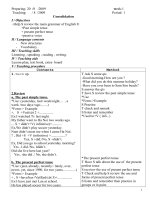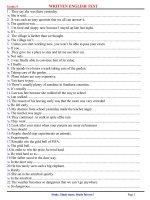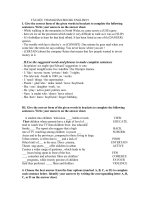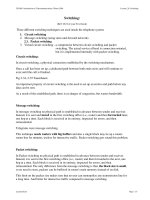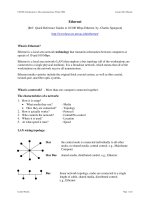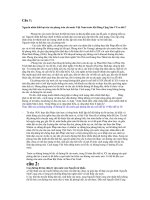Tài liệu Read & Think ENGLISH pdf
Bạn đang xem bản rút gọn của tài liệu. Xem và tải ngay bản đầy đủ của tài liệu tại đây (3.5 MB, 222 trang )
Read & Think
ENGLISH
This page intentionally left blank
Read & Think
ENGLISH
Los editores de la revista Think English!
New York Chicago San Francisco Lisbon London Madrid Mexico City
Milan New Delhi San Juan Seoul Singapore Sydney Toronto
Copyright © 2008 by Second Language Publishing. All rights reserved. Manufactured in the United States of America. Except as permitted under the
United States Copyright Act of 1976, no part of this publication may be reproduced or distributed in any form or by any means, or stored in a database
or retrieval system, without the prior written permission of the publisher.
0-07-159627-5
The material in this eBook also appears in the print version of this title: 0-07-149914-8.
All trademarks are trademarks of their respective owners. Rather than put a trademark symbol after every occurrence of a trademarked name, we use
names in an editorial fashion only, and to the benefit of the trademark owner, with no intention of infringement of the trademark. Where such
designations appear in this book, they have been printed with initial caps.
McGraw-Hill eBooks are available at special quantity discounts to use as premiums and sales promotions, or for use in corporate training programs.
For more information, please contact George Hoare, Special Sales, at or (212) 904-4069.
TERMS OF USE
This is a copyrighted work and The McGraw-Hill Companies, Inc. (“McGraw-Hill”) and its licensors reserve all rights in and to the work. Use of this
work is subject to these terms. Except as permitted under the Copyright Act of 1976 and the right to store and retrieve one copy of the work, you may
not decompile, disassemble, reverse engineer, reproduce, modify, create derivative works based upon, transmit, distribute, disseminate, sell, publish or
sublicense the work or any part of it without McGraw-Hill’s prior consent. You may use the work for your own noncommercial and personal use; any
other use of the work is strictly prohibited. Your right to use the work may be terminated if you fail to comply with these terms.
THE WORK IS PROVIDED “AS IS.” McGRAW-HILL AND ITS LICENSORS MAKE NO GUARANTEES OR WARRANTIES AS TO THE
ACCURACY, ADEQUACY OR COMPLETENESS OF OR RESULTS TO BE OBTAINED FROM USING THE WORK, INCLUDING ANY
INFORMATION THAT CAN BE ACCESSED THROUGH THE WORK VIA HYPERLINK OR OTHERWISE, AND EXPRESSLY DISCLAIM
ANY WARRANTY, EXPRESS OR IMPLIED, INCLUDING BUT NOT LIMITED TO IMPLIED WARRANTIES OF MERCHANTABILITY OR
FITNESS FOR A PARTICULAR PURPOSE. McGraw-Hill and its licensors do not warrant or guarantee that the functions contained in the work will
meet your requirements or that its operation will be uninterrupted or error free. Neither McGraw-Hill nor its licensors shall be liable to you or anyone
else for any inaccuracy, error or omission, regardless of cause, in the work or for any damages resulting therefrom. McGraw-Hill has no responsibility
for the content of any information accessed through the work. Under no circumstances shall McGraw-Hill and/or its licensors be liable for any indirect,
incidental, special, punitive, consequential or similar damages that result from the use of or inability to use the work, even if any of them has been
advised of the possibility of such damages. This limitation of liability shall apply to any claim or cause whatsoever whether such claim or cause arises
in contract, tort or otherwise.
DOI: 10.1036/0071499148
We hope you enjoy this
McGraw-Hill eBook! If
you’d like more information about this book,
its author, or related books and websites,
please click here.
Professional
Want to learn more?
Contents
INTRODUCCIÓN X
INSTRUCCIONES
PARA EL ÉXITO
XII
Culture
The American Dream La inmigración y el sueño americano 4
A Melting Pot
Una mezcla de culturas diferentes 5
The American Cowboy
El vaquero, un icono americano 6
American Jazz
La música más innovadora de América 8
Singing the Blues
Las raíces y sonidos del blues 10
Native American Culture
Los primeros habitantes de América 11
African Heritage
Los afro-americanos, pasado y presente 12
Early American Literature
La literatura norteamericana 14
Artistic Expression
La expresión artísica 15
The Birthplace of Broadway
La historia de Broadway 16
Cultural Values
Importantes valores estadounidenses 18
Test your comprehension
Examina tu comprensión 20
Travel
Camping Trips Acampando por todo el país 24
Rafting the Grand Canyon
El rafting en el Gran Cañón 25
Down by the Boardwalk
Los mejores paseos marítimos 26
Treasure Islands
Explore las Islas Hawaianas 28
The First National Park
El primer parque nacional 30
A Walking Tour of D.C
Una caminata visitando monumentos 32
Unique Accommodations
Duerma en un faro 34
Made in the USA
Visitas guiadas a fábricas 36
Home on the Range
Pase las vacaciones con los vaqueros 37
San Juan Orcas
Avistando ballenas en el Estrecho Puget 38
Go to Jail! Visite la famosa prisión de Alcatraz 39
Test your comprehension
Examina tu comprensión 40
For more information about this title, click here
Tradition
Choices in Education Opciones y prácticas educativas 44
Prom and Homecoming
Bailes escolares tradicionales 45
Traditions for the New Year
Celebraciones de Año Nuevo 46
Going to the Chapel
Costumbres de bodas y casamientos 48
April Fools!
Bromas y travesuras 49
An American Christmas
Celebrando la Navidad en Estados Unidos 50
Giving Thanks
Un día para dar gracias 52
America’s Favorite Sport
Fútbol americano, deporte favorito 54
The National Pastime
Béisbol, el deporte y sus tradiciones 56
The American Flag
Importancia y signifi cado de la bandera 58
Trick or Treat
Tradiciones y juegos de Halloween 60
Remembrance and Honor
Día festivo de honor y recuerdo 61
Test your comprehension
Examina tu comprensión 62
Celebration
Luck of the Irish Celebraciones del Día de San Patricio 66
Groundhog Day
¡Una marmota predice el tiempo! 67
Powwows
Rituales de los Nativos Americanos 68
Seasonal Celebrations
Festivales y diversión en toda estación 70
Flavor of America
Famosos festivales de alimentos 72
Earth Day
Un día para cuidar a la Tierra 74
Parents Appreciation Day
Día de la Madre y del Padre 75
Season Of Merriment
Mardi Gras en Nueva Orleans 76
A Salute to Spring
Tradiciones y creencias de la Pascua 78
Celebrating Workers
Honrando a los trabajadores 79
Shakespeare Festivals
Ferias para fanáticos de Shakespeare 80
Martin Luther King Day
En recuerdo y honor 81
Ethnic Celebrations
Celebraciones para diferentes culturas 82
Test your comprehension
Examina tu comprensión 84
vi
vii
People
Trail of Discovery Descubriendo el oeste americano 88
Mother of Civil Rights La madre de los derechos civiles 89
The Founding Fathers Los fundadores de los Estados Unidos 90
The Best of Two Worlds Entrevista con Pepe Stepensky 92
Frank Lloyd Wright El arquitecto más infl uyente 94
Rags to Riches La fi lantropía de Andrew Carnegie 95
America Takes Flight Los hermanos Wright 96
Dr. Seuss Amado autor de cuentos infantiles 97
Author and Preservationist John Muir, autor y activista 98
Dr. Jonas Salk El hombre que salvó a los niños 99
Angel of the Battlefi eld Ángel del campo de batalla 100
Let There Be Light Thomas Edison y la bombilla eléctrica 101
Hispanic Americans’ Famous Firsts Famosas primicias 102
Test your comprehension Examina tu comprensión 104
Business
Introduction to Taxes Todo sobre los impuestos 108
Entrepreneurship Montando un negocio 110
Banking in America El sector bancario y las fi nanzas 112
Negotiating Your Salary Negociando tu salario 114
Retirement Plans Aprendiendo sobre planes de jubilación 116
Mastering the Interview Dominando tu entrevista laboral 118
Test your comprehension Examina tu comprensión 120
Empowerment
Citizenship Ciudadanía estadounidense 124
Civic Participation
Programas y participación cívica 125
Empowerment with Education
Educación y éxito 126
Community Colleges
Oportunidades en institutos terciarios 128
Helping Children Succeed
Tus hijos en la escuela 130
Maximizing Your Talents
Oportunidades laborales para bilingües 132
Legal Resources
Ayuda y recursos legales 134
Public Benefi ts
Tus derechos a benefi cios 135
Owning Your Own home
Comprando una casa 136
Parent-Teacher Association
Asociación de Padres y Maestros 137
You and Your community
Explora tu comunidad 138
Hispanics in the Workplace
Hispánicos en el lugar de trabajo 140
Test your comprehension
Examina tu comprensión 142
History
Independence Day Día de la Independencia 146
Stars and Stripes
La bandera estadounidense 147
The Electoral College
Seleccionando presidentes 148
Supreme Law of the Land
Ley suprema de la nación 149
Divisions of Power
Leyes del gobierno 150
History of the White House
La casa blanca 152
The Bill of Rights
Derechos individuales 153
United States Presidency
Presidencia estadounidense 154
The American Revolution
La revolución de la nación 156
The Underground Railroad
Esclavos encuentran libertad 158
A Time of Crisis
La Gran Depresión 159
Spanish-American War
En guerra contra España 160
Women’s Right to Vote
El derecho al voto de las mujeres 161
Test your comprehension
Examina tu comprensión 162
viii
ix
Geography
World Heritage Sites Lugares de interés 166
Majestic Mountains
Montañas, grandes y pequeñas 168
North American Deserts
Clima y vida de los desiertos 170
The Great Lakes
Los cinco Grandes Lagos 172
Protecting Our Environment
Protegiendo el medio ambiente 173
Land of Waterfalls
Cataratas increíbles 174
Tropical Rain Forests
Bosque pluvial de Hawai 176
Temperate Rain Forests
Bosques pluviales templados 177
Volcanoes of the United States
Volcanes de los Estados Unidos 178
Test your comprehension
Examina tu comprensión 180
Gastronomy
American Apple Pie Manzanas y pastel de manzana 184
Taste of America
Deliciosa cocina regional 186
Blue Plate Special
Restaurantes económicos 188
Chocolate Chip Cookies
Galletitas con trocitos de chocolate 190
Buffalo Wings
Pollo picante y sabroso 192
Saltwater Taffy
Regalitos de la playa 193
Waldorf Salad
Una ensalada simple y famosa 194
Clam Chowder
Una sopa favorita 195
Farmers’ Markets
Mercados de agricultores 196
Soul Food
La comida del sur 197
American Barbecue
Barbacoa, ¡tradición y delicia culinaria! 198
Test your comprehension
Examina tu comprensión 200
ANSWER KEY 202
x
Introducción
Read & ink English representa un enfoque innovador y fácilmente accesible al
aprendizaje de una lengua extranjera. Se trata de un método dinámico de inmersión
al lenguaje, diseñado para usar en casa y aumentar su dominio del inglés a través del
estudio de la vida y cultura de los Estados Unidos.
Hemos creado Read & ink English con el siguiente propósito: hacer más fácil el
perfeccionamiento y la fl uidez de su inglés, y aumentar su conocimiento sobre la
vida y cultura norteamericanas para así incrementar sus oportunidades de éxito en
los Estados Unidos.
Nuestro sistema de aprendizaje ha sido diseñado para hacer uso de sus conocimien-
tos previos del inglés y ampliarlos, presentando el vocabulario y las frases en contex-
tos relevantes y estimulantes, que además ponen énfasis en las cuatro aptitudes del
lenguaje: la lectura, la escritura, el lenguaje hablado y la comprensión del idioma.
Read & ink English hace del inglés una lengua viva! Lea sobre la historia de los
Estados Unidos y descubra las personas que contribuyeron a su formación. Explore
las tradiciones y peculiares costumbres que se asocian con este país. Y, recuerde que,
mientras Ud. disfruta con los fascinantes artículos, está aprendiendo inglés.
Profesores y estudiantes de todas las edades usan Read & ink English para aumen-
tar el dominio de su inglés de una manera natural y efi caz. Tanto si el programa se
usa como complemento en el salón de clase o como guía privada de estudio, los
resultados son los mismos: Ud. desarrollará y mejorará sus conocimientos de voca-
bulario y gramática.
La información provista en cada capítulo facilita la mejor comprensión de la vida en
los Estados Unidos y esto, a su vez, fomenta un mayor interés y éxito en el apren-
dizaje del inglés. Cada artículo va acompañado de un glosario bilingüe, de manera
que se puede leer y aprender sin pararse a buscar palabras en el diccionario o en un
manual de conversación.
Copyright © 2008 by Second Language Publishing. Click here for terms of use.
xi
Read & ink English se ajusta a diferentes niveles de aptitud, desde el elemental
hasta el avanzado:
Elemental: Se recomienda que el nivel de conocimiento de inglés del estu-
diante sea equivalente al de la escuela secundaria o al del primer semestre de
universidad. Tanto si su experiencia previa con el inglés ha sido a través de
estudios escolares o bien personales, Read & ink English le permitirá sumer-
girse en la lengua y la cultura y también aumentará su comprensión sobre la
estructura de la oración y el uso de los verbos.
Intermedio: Como estudiante de nivel intermedio, Ud. aprenderá más voca-
bulario y frases nuevas y notará un aumento en su fl uidez y su capacidad de
comprensión.
Avanzado: El estudiante avanzado continuará adquiriendo información valio-
sa y relevante, ya que el aprendizaje de una lengua es un esfuerzo para toda la
vida.
Read & ink English es un método efi caz, divertido y asequible, sin importar cual es
su nivel actual de conocimientos.
Experimente Ud. el entusiasmo y la satisfacción que vienen de aprender un nuevo
idioma y descubrir una nueva cultura. Lea, hable, disfrute… Piense en Inglés.
Instrucciones para el éxito
El programa Read & ink English está dividido en capítulos que guían al estudiante
a través de la vida en los Estados Unidos. Al fi nal de cada capítulo hay una sección
llamada “Compruebe su comprensión.” Esta sección fomenta el desarrollo de la
comprensión de lectura y favorece la comprensión del inglés escrito.
No es necesario leer Read & ink English de principio a fi n, ni tampoco en un orden
determinado. Se puede leer por capítulos o escoger un capítulo o artículo que sea
de especial interés para el lector. Se pueden completar las preguntas de las pruebas
artículo por artículo, o bien por capítulos. Esta fl exibilidad le permite al usuario
avanzar a su propio ritmo, leyendo y releyendo el material según su necesidad. Los
artículos, que son de gran interés, hacen que el estudio sea más agradable y la lectura
más estimulante.
En primer lugar, lea el artículo para tener una idea general del tema. No se
preocupe si al principio no comprende todo el vocabulario.
Una vez que comprenda de qué se trata el artículo, léalo de nuevo
fi jándose en el vocabulario que no conoce. Ponga especial atención al
contexto donde se usa dicho vocabulario.
Lea el artículo en voz alta.
Si tiene acceso a un sistema de grabación, haga práctica grabando los
artículos o pídale a alguien que habla español que se los grabe. Luego,
escuche las grabaciones y observe cómo su comprensión auditiva va
mejorando con el tiempo.
¡Repita, Repita, Repita! Esto es especialmente importante cuando se trata de
memorizar partes y formas de las palabras que son importantes. La repetición activa
es, algunas veces, la única manera de recordar detalles difíciles de retener en la
memoria. Estas frecuentes repeticiones orales ayudan a fi jar las formas en su “oído
interno.” Esta dimensión auditiva le ayudará a recordar las palabras más adelante.
Con Read & ink English, Ud. tiene la oportunidad de repetir diferentes procesos
de aprendizaje tantas veces como quiera y tan a menudo como lo considere necesario.
Lea, escuche y hable una y otra vez: esto le será de gran ayuda para alcanzar su meta
de dominar la lengua inglesa.
xii
Copyright © 2008 by Second Language Publishing. Click here for terms of use.
xiii
Glosario bilingüe a la medida
Al lado de cada artículo se encuentra un glosario bilingüe correspondiente fácil-
mente accesible. Entonces, como ya no es necesario interrumpir la lectura para usar
un diccionario, la comprensión y la adquisición de vocabulario se producen de una
manera mucho más cómoda y rápida.
Cada artículo contiene gramática nueva y también vocabulario y frases nuevas, así
como repeticiones de vocabulario y frases previamente estudiados. Las repeticiones
a lo largo de los artículos sirven para aumentar la comprensión de la lectura y fa-
cilitar la memorización. Los artículos están escritos desde distintas perspectivas, y,
aunque la mayoría de ellos están escritos en la tercera persona, hay algunos escritos
en la primera también. Este cambio de persona gramatical ayuda al lector a recono-
cer la conjugación de los diferentes tiempos de los verbos.
Muchos profesores de inglés recomiendan “crear una imagen mental” de las pala-
bras extranjeras o asociarlas con objetos y situaciones familiares para aumentar la
memorización de las mismas. Sin embargo, con Read & ink English, no necesitará
“crear” ninguna imagen. Las imágenes se crean automáticamente en su imaginación
con el desarrollo de la historia. Lea sin prisas y, al leer, imagínese la historia tal y
como está escrita y vaya absorbiendo el vocabulario nuevo. Si una palabra o frase
es especialmente difícil, trate de asociarla con una imagen que ella representa en la
historia, mientras la pronuncia en voz alta.
Los verbos están escritos en el glosario, primero en la forma conjugada con que
aparecen en la historia y después en el infi nitivo. Por ejemplo: looking for/to look
for: buscando /buscar
Compruebe su comprensión
Las preguntas de las pruebas que hay al fi nal de cada capítulo están diseñadas para
que Ud. siga desarrollando sus destrezas de comprensión de la lectura y para asegu-
rar su éxito en el estudio del inglés. Además, Ud. aprenderá a usar el contexto para
determinar signifi cados. Cuando se entiende el contexto en general, muchas veces
se puede “adivinar” el signifi cado de palabras desconocidas basándose en el contexto
de una oración, un párrafo o un artículo. Las respuestas se encuentran al fi nal del
xiv
Información Sobre la Autora
Los artículos contenidos en este libro fueron escritos, coordinados y recopilados bajo
la dirección de Kelly Garboden, Fundadora y Editora de la editorial Second Language
Publishing (SLP). SLP es una editorial educativa que publica las revistas ink
Spanish Magazine y ink English Magazine. SLP se especializa en la elaboración de
productos interesantes e informativos dedicados al aprendizaje de idiomas. Dichos
productos tienen como objetivo superar las barreras de comunicación y fomentar el
aprendizaje del idioma y la integración cultural. Para más información sobre Second
Language Publishing y ink English Magazine visite la siguiente dirección web:
www.thinkenglishmagazine.com
Un Agradecimiento Especial Para:
Jean Garboden, Miguel Romá, Lucía Terra and LuciaTerra.com, Karen Young,
Mesia Quatro and LatPro.com, Jessica Harrison, Ian Chaplin and Cleo Chaplin
Read & Think
ENGLISH
I like to see a man proud of the place in which he lives.
I like to see a man live so that his place will be proud of him.
Abraham Lincoln
Culture
Copyright © 2008 by Second Language Publishing. Click here for terms of use.
4 culture
e American Dream is often associated with immigration. For years,
the dream of prosperity and freedom has driven immigrants to the
United States. America is viewed as the land of opportunity and
immigrants from all over the world have settled in the U.S. with dreams
of a fresh start and a new life.
By the 1900’s, the promise of the American Dream had begun to
attract large numbers of immigrants looking for work in large cities.
With hard work and determination immigrants hoped to escape the
class boundaries of their home countries.
e Industrial Revolution helped shape the American Dream by
creating thousands of jobs. e development of big business, the
Transcontinental Railroad, and the increase in oil production improved
the American standard of living. “Rags to riches” stories of business
tycoons led to the belief that if you had intelligence, and a willingness
to work hard, you were likely to live a successful life.
When people think of the American Dream they think of a successful
and satisfying life. e term usually implies fi nancial security and
material comfort, but can also mean living a fulfi lling life.
It is said that James Truslow Adams coined the term “American Dream”
in his book e Epic of America. However, Truslow’s coinage of the
phrase had a broader meaning.
e American Dream is “that dream of a land in which life should be better
and richer and fuller for everyone, with opportunity for each according to
ability or achievement. It is not a dream of motor cars and high wages
merely, but a dream of social order in which each man and each woman
shall be able to attain to the fullest stature of which they are innately
capable, and be recognized by others for what they are, regardless of the
fortuitous circumstances of birth or position.”
How do you achieve the American Dream? at answer depends upon
your personal defi nition of the term. Luckily for us, living in America—the
land of opportunity, there are many dreams to choose from!
The American Dream
often associated: a menudo asociado
prosperity: prosperidad
freedom: libertad
driven/to drive: llevar/lleva
viewed: vista
land of opportunity: tierra de
la oportunidad
have settled/to settle: se han
establecido/establecerse
fresh start: nuevo comienzo
new life: nueva vida
promise: promesa
had begun/to begin: había empezado/
empezar
to attract: a atraer
looking for/to look for: buscando/
buscar
hoped to escape: esperaban escapar
class boundaries: límites de clase
helped shape: ayudaron a dar forma
creating/to create: creando/crear
thousands: miles
development: desarrollo
big business: grandes negocios
standard of living: estándar de vida
tycoons: magnates
willingness: voluntad, buena
disposición
think/to think: piensa/pensar
implies/to imply: implica/implicar
fi nancial security: seguridad fi nanciera
material comfort: confort material
coined the term: inventó el término
broader meaning: signifi cado más
amplio
land: tierra
according: de acuerdo
ability: habilidad
wages: salarios
merely: solamente
be able to attain: ser capaz de alcanzar
fullest stature: máxima estatura
innately capable: innatamente capaces
recognized: reconocidos
birth: nacimiento
position: posición
achieve/to achieve: logras/lograr
answer: respuesta
depends: depende
luckily: afortunadamente
living: viviendo
to choose: elegir
Copyright © 2008 by Second Language Publishing. Click here for terms of use.
e term melting pot is strongly
associated with the United States.
e U.S. is a melting pot of peo-
ple from diff erent cultures and
races. roughout the U.S. you
will notice diff erences in the way
people live, eat and even talk.
While American English is generally standard, American speech can
diff er according to what part of the country you are in.
Certain traits and personalities are also connected with certain regions.
Westerners are known as the least traditional of Americans, and the
most tolerant of change and diff erences. Midwesterners are known for
being honest, straightforward people of traditional values.
e southwest has had the least infl uence by European immigrants.
Much of its culture has been defi ned by native Americans and by the
Spanish.
Southerners are probably the most distinctive of all American regional
groups, with more relaxed attitudes and traditional ways than their
neighbors to the north. ey are known for their hospitality.
e Northeast is well known for its culture with excellent theaters and
museums. It is also regarded for its educational system with some of the
most highly rated and respected universities in the country.
is region
is also known for its large mix of ethnic groups.
Every time we speak, we say volumes about where we are from; the
neutral tones of the Midwest, the rapid speech of New York City, the
long drawl that characterizes the South. If you say a certain word or
phrase, people will most likely be able to guess where you are from.
A Melting Pot
term: término
strongly: fuertemente
associated with: asociados con
people: personas
races: razas
throughout: por todos
you will notice: tú notarás
diff erences: diferencias
way: forma
live/to live: vive/vivir
eat/to eat: come/comer
even: incluso
talk/to talk: habla/hablar
while: aunque
generally: generalmente
standard: estándar
speech: habla
diff er: diferir
according to: dependiendo de
country: país
traits: rasgos
personalities: personalidades
connected/to connect: conectadas/
conectar
known as: conocidos como
least: menos
most tolerant: más tolerantes
change: cambio
honest: honesta
straightforward: directa
values: valores
has been defi ned/to defi ne: ha sido
defi nida/defi nir
probably: probablemente
distinctive: distintivo, característico
relaxed attitudes: actitudes relajadas
neighbors: vecinos
hospitality: hospitalidad
museums: museos
regarded: respetado, estimado
highly rated: altamente valoradas
respected: respetadas
mix: mezcla
ethnic groups: grupos étnicos
every time: cada vez
say/to say: decimos/decir
volumes: mucho
neutral tones: tonos neutrales
rapid speech:
habla rápida
long drawl: largo acento arrastrado
characterizes/to characterize:
caracteriza/caracterizar
certain: cierta
word: palabra
phrase: frase
most likely: seguramente
guess: adivinar
culture 5
Copyright © 2008 by Second Language Publishing. Click here for terms of use.
6 culture
e central character of America’s
colorful ranching heritage is the
cowboy. e American cowboy
has played an important part in
American culture and history. e
cowboy infl uence is embedded in
stories, songs, legends, movies, art
and fashion.
Although the cowboy is generally considered an American icon, the
traditional cowboy actually comes from a Hispanic tradition, which
originated in Central Mexico, known as “charro.”
At the end of the Civil War, many soldiers had no home, and no place
to go. ey started drifting to the West. Cowboys roamed and worked
throughout the Wild West. To many, this term means guns, cattle, horses
and gunfi ghts. It was a rugged country with few amenities and a lot of
danger. e Western territories were appealing to the adventurous, and
they were open and untamed. Many of these men only owned what
they could carry on horseback. Ranchers hired these hard-working
men as ranch hands. e ranch hands tended to the herd and did work
around the ranch. When the time came to sell the beef, the ranch hands
would roun
d up the herd from the open prairie and drive the cattle
miles to market.
Popular stories about the cowboys depicted them as rustlers or
professional gunfi ghters. While this is true in some cases, the average
American cowboy was often lonely, lived in harsh conditions, and was
frequently exposed to danger. Despite this, the cowboys always kept
their sense of humor and joked about everything. ey did not make
much money and enjoyed the simple way of life.
central character: personaje central
colorful: colorido
ranching: relacionado a las actividades
de un rancho
has played/to play: ha jugado/jugar
is embedded/to embed: está
incrustada/incrustar
stories: historias, cuentos
legends: leyendas
although: a pesar de
generally: generalmente
considered/to consider: considerado/
considerar
icon: icono
comes from/to come from: proviene
de/provenir de
Civil War: Guerra Civil
soldiers: soldados
drifting/to drift: vagando/vagar, ir a la
deriva, desviarse hacia
roamed/to roam: vagaban/vagar
worked/to work: trabajaban/trabajar
means/to mean: signifi ca/signifi car
guns: pistolas
cattle: ganado
gunfi ghts: tiroteos
rugged country: una tierra dura
amenities: servicios
danger: peligro
appealing: atractivos
open and untamed: abiertos y sin
domesticar
owned/to own: poseían/poseer,
ser propietario
carry/to carry: cargar/cargar
horseback: a lomo de caballo
ranchers: rancheros
hired/to hire: contrataban/contratar
hard-working: trabajadores
ranch hands: mano de obra para el
rancho
tended to/to tend to: atendían/atender
the herd: el rebaño, la manada
when the time came: cuando llegaba
el momento
round up/to round up: rodear/rodear
open prairie: pradera abierta
drive/to drive: conducir/conducir
market: mercado
depicted/to depict: pintaban/pintar
rustlers: ladrones de ganado
while: aunque
in some cases: en algunos casos
often: a menudo
harsh conditions: duras condiciones
exposed: expuesto
despite this: a pesar de esto
joked/to joke: bromeaban/bromear
simple way of life: estilo de vida simple
The American Cowboy
Copyright © 2008 by Second Language Publishing. Click here for terms of use.
culture 7
tough as nails: duros como clavos
(una expresión)
generous: generosos
hospitable: hospitalarios
embodiment: personifi cación
rugged independence: fuerte
independencia
real life: vida real
later: más tarde
silver screen: pantalla
sang/to sing: cantaban/cantar
songs: canciones
did tricks: hacían trucos
shiny: brillantes
modern: modernos
working: que trabajan
being: ser
a thing of the past: una cosa del
pasado
exact: exacto
unknown: desconocido
responsible: responsables
feeding: alimentar
livestock: ganado
branding/to brand: marcar/marcar
tending to: ocuparse de
injuries: heridas, lesiones
herd/to herd: guarda/guardar, reunir
o llevar en manada
repair/to repair: reparan/reparar,
arreglar
fences: cercas
maintain/to maintain: mantienen/
mantener
perform/to perform: realizan/realizar
odd jobs: tareas sueltas
last, but not least: último, pero no
menos importante
cowgirl: vaquera
not as well documented: no tan bien
documentada
companies: compañías, empresas
have dedicated/to dedicate: han
dedicado/dedicar
researching/to research: investigar/
investigar
National Cowgirl Museum and Hall
of Fame: Museo Nacional y Sala de
Fama de la Vaquera
to document: para documentar
Tough as nails, but generous and hospitable, these were the true Wild
West American cowboys. e cowboy was the embodiment of rugged
independence. Some names you might be familiar with are Butch
Cassidy and e Sundance Kid, Buff alo Bill, Billy the Kid, Wyatt Earp
and Doc Holiday.
Many of these cowboys became legends in real life and later legends of
the silver screen. ey rode horses. ey sang songs. eir horses did
tricks and their guns were shiny. ey became American heroes.
MODERN WORKING COWBOYS
Being a cowboy is certainly not
a thing of the past. roughout
the U.S., you will fi nd cowboys
working on ranches and farms.
e exact number of working
cowboys is unknown. Cowboys
are responsible for feeding the
livestock, branding cattle and
horses, and tending to injuries.
ey also move the livestock
to diff erent pasture locations, or herd them into corrals. In addition,
cowboys repair fences, maintain ranch equipment, and perform other
odd jobs around the ranch.
And last, but not least: the cowgirl! e history of women in the west
is not as well documented as that of men. However, in recent years
companies have dedicated time and money to researching the cowgirl
tradition.
e National Cowgirl Museum and Hall of Fame has made
great eff orts to document the history of cowgirls.
8 culture
American Jazz
Jazz is considered the most signifi cant, infl uential and innovative music
to emerge from the United States. New Orleans, Louisiana, is widely
known as the birthplace of jazz.
Jazz can make the listener feel happy or sad, mellow or energetic. Jazz
can sound loud or soft. Performers of jazz improvise and create music
as they play.
Jazz has its roots in the nineteenth
century. In the late 1880’s, African-
Americans began to develop new
forms of music. ey created blues
music from the gospel music and
sad songs of their years in slavery.
From the blues came the fi rst true
jazz music. is happened during
the early 1900’s in Louisiana.
Classic, traditional or Dixieland jazz
came out of the music originating
in New Orleans.
During the 1920’s, jazz continued to gain popularity. Louis Armstrong
became famous for his performances on the trumpet and for his
unusual voice. Louis Armstrong became one of the most infl uential and
loved U.S. jazz musicians. Historians call the 1920’s the Golden Age
of American Jazz.
As time passed, a jazz form called “swing” became very popular in
America. People danced to swing music until after World War II.
Benny Goodman led one of America’s most successful swing bands.
People called Goodman “ e King of Swing.” Goodman also presented
black and white jazz musicians playing together for the fi rst time.
is considered: está considerado
signifi cant: importante, relevante
to emerge/to emerge: que ha surgido/
surgir
widely known: ampliamente conocido
birthplace: lugar de nacimiento
make/to make: hacer/hacer
listener: oyente
feel/to feel: se sienta/sentir
happy: alegre
sad: triste
mellow: sosegado
energetic: energizado
sound/to sound: sonar/sonar
loud: fuerte
soft: suave
performers: intérpretes
improvise/to improvise: improvisan/
improvisar
create/to create: crean/crear
has its roots: tiene sus raíces
century: siglo
to develop: a desarrollar
gospel music: música gospel (gospel:
evangelio)
sad songs: canciones tristes
slavery: esclavitud
the fi rst true: la primera verdadera
happened/to happen: ocurrió/ocurrir,
tener lugar
during: durante
came out of/to come out of: se originó
en/originarse en
to gain popularity: adquirió
popularidad
became/to become: se hizo (famoso)/
hacerse (famoso)
trumpet: trompeta
unusual: poco corriente
call/to call: llaman/llamar
Golden Age: Edad de Oro
as time passed: con el tiempo
danced/to dance: bailaba/bailar
led/to lead: dirgió/dirigir
swing bands: bandas de swing
presented/to present: presentó/
presentar
playing together: tocando juntos
fi rst time: primera vez
Copyright © 2008 by Second Language Publishing. Click here for terms of use.
After World War II, swing jazz became less popular. Americans began
to listen to diff erent sounds. One was bebop. Young musicians had
created bepop in the 1940’s and it gained popularity slowly over the
years. e music seemed harshly diff erent to the ears of the public.
Bebop appeared to sound racing, nervous, and often fragmented.
Nevertheless, bebop was an exciting and beautiful revolution in the
art of jazz.
In the 1950’s, cool jazz became popular. Cool jazz instruments sound
softer than in bebop and the rhythm is more even.
With cool jazz came many new listeners. People went to jazz clubs and
bought jazz recordings. e introduction of the long-playing record
also helped the music become more popular.
In the 1960’s a new kind of music, rock and roll, grew very popular in
the US. People throughout the world listened to the rock music of
Elvis Presley and the Beatles. is new music cut into the popularity
of jazz.
In the 1980’s, trumpet player
Wynton Marsalis helped lead a
return to more traditional jazz.
is mainstream jazz borrows
sounds from swing, bebop and
cool jazz. Marsalis is one of the
most well known and praised jazz
musicians.
Today, jazz musicians play all types of music. Jazz can sound like swing
or bebop. It can sound like rock and roll. It can sound like American
Western music. It can sound like the music of several nations and ethnic
groups. Or, it can sound traditional. With so many options to choose
from, people of all ages and all walks of life can fi nd enjoyment and
an appreciation for American jazz.
after: luego, después de
less: menos
began to listen: empezaron a escuchar
young: jóvenes
gained/to gain: ganó/ganar
slowly: lentamente
harshly diff erent: marcadamente
diferente
ears: oídos
racing: rápida, relativa a las carreras
nervous: nerviosa
fragmented: fragmentada
nevertheless: sin embargo, no obstante
revolution: revolución
sound/to sound: suenan/sonar
softer: más suave
more even: más parejo
new: nuevos
clubs: clubes
bought/to buy: compraba/comprar
recordings: grabaciones
long-playing record: disco long-play
throughout: a través de, por todo
listened to/to listen to: escuchaban/
escuchar
cut into/to cut into: quitó una parte/
quitar, interrumpir
helped/to help: ayudó/ayudar
lead a return: dirigir una vuelta
mainstream: corriente dominante
borrows/to borrow: toma prestados/
tomar prestado
most well known: bien conocido
praised: alabados
all types: todo tipos
so many options: tantas opciones
to choose from/to choose: de las cuales
elegir/elegir
ages: edades
all walks of life: de toda condición
fi nd/to fi nd: encontrar/encontrar
enjoyment: diversión
appreciation: aprecio
cultura 9

